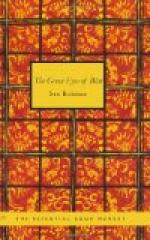“I think,” said Gatton, taking the figure from me and looking at it with a singular expression on his face, “that the history of the thing is very important. The fact that a rough reproduction of a somewhat similar figure is painted upon the case cannot possibly be a coincidence.”
I stared at him silently for a moment, then:
“You mean that the crate was specially designed to contain the body?” I asked.
“I am certainly of that opinion,” declared Inspector Heath, the local officer. “It is of just the right size and shape for the purpose.”
Once more I began to examine the fragments stacked upon the floor, and then I looked again at the several objects which lay beside the crate. They were the personal belongings of the dead baronet and the police had carefully noted in which of his pockets each object had been found. He was in evening dress and a light top-coat had been packed into the crate beside him. In this had been found a cigar-case and a pair of gloves; a wallet containing L20 in Treasury notes and a number of cards and personal papers had fallen out of the crate together with the cat statuette. The face of his watch was broken. It had been in his waistcoat pocket but it still ticked steadily on where it lay there beside its dead owner. A gold-mounted malacca cane also figured amongst the relics of the gruesome crime; so that whatever had been the object of the murderer, that of robbery was out of the question.
“The next thing to do,” said Gatton, “is to trace Sir Marcus’s movements from the time that he left home last night to the time that he met his death. I am going out now to ’phone to the Yard. We ought to have succeeded in tracing the carter who brought the crate here before the evening. I personally shall proceed to Sir Marcus’s rooms and then to this Red House around which it seems to me that the mystery centers.”
He put the enamel figure into his pocket and taking up the broken board which bore the painted cat:
“You are carrying a top-coat,” he said. “Hide this under it!”
He turned to Inspector Heath, nodding shortly.
“All right,” he said, with a grim smile, “go out now and talk to the crowd!”
Having issued certain telephonic instructions touching the carter who had delivered the crate to the docks, and then imparting to the representatives of the press a guarded statement for publication, Inspector Gatton succeeded in wedging himself into my little two-seater and ere long we were lurching and bumping along the ill-paved East-end streets.
The late Sir Marcus’s London address, which had been unknown to me, we had learned from his cards, and it was with the keenest anticipation of a notable discovery that I presently found myself with Gatton mounting the stairs to the chambers of the murdered baronet.
At the very moment of our arrival the door was opened and a man—quite obviously a constable in plain clothes—came out. Behind him I observed one whom I took to be the late Sir Marcus’s servant, a pathetic and somewhat disheveled figure.




